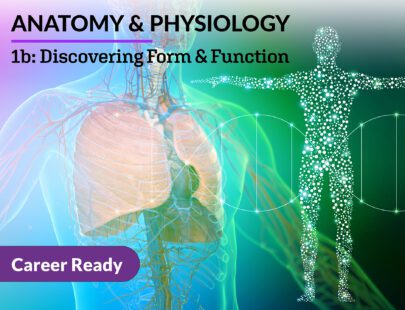
Pharmacology 1a: Introduction
If you ever thought about pursuing a gratifying career in biomedical sciences, pharmacology is a must. Pharmacology is the fascinating study of the chemistry, origins, and types of medications. Whether you plan on going into medicine, nursing, dentistry, veterinary medicine, or pharmacy, you’ll need to learn the effects of medicines on different biological systems, appropriate dosages, and how the body responds to different medications.
Units at a Glance
Unit 1: Principles of Pharmacology
Pharmacology is the fascinating study of the chemistry, origins, and types of medications. Like other branches of science and medicine, pharmacology uses specific terminology and a language as unique as English is to the United States and Italian is to Italy. And, in order to be able to understand the pharmacological sciences, those who research, develop, prescribe, and administer medications need to first be able to learn that language. Here, we’ll introduce you to the language of pharmacy and the terms you will need to support your journey!
What will you learn in this unit?
- Define pharmacology, pharmacodynamics, pharmacokinetics, and pharmacotherapeutics
- Distinguish between therapeutic effects, side effects, and toxic effects
- Describe the advantages and disadvantages related to the routes of medication administration
- Explain medical terms associated with drug forms
Unit 2: Medication Math
Medication dose calculations, if done incorrectly, can have serious and sometimes fatal consequences. To prevent causing harm, anyone involved in the prescribing, dispensing, or administering of medications must have knowledge of basic math, be able to convert between various units of measurement, and know how to interpret medication orders. Read on to get the tools you need to be sure you can perform medication calculations accurately — this is information no one should miss!
What will you learn in this unit?
- Demonstrate an ability to use metric and household measurement systems
- Convert units of measurement
- Solve one- and two-step medication calculation problems
- Calculate intravenous drip rates
Unit 3: Fluids and Electrolytes
One of the most important parts of patient care is keeping the various body functions stable, known as homeostasis. Electrolyte and fluid balance plays the most significant role in controlling all body mechanisms. Understanding how to manage this requires knowledge of the various components of body fluids and what happens when they are out of balance. Together, we’ll explore these concepts so you can confidently deliver quality care.
What will you learn in this unit?
- Describe the concept of fluid balance and homeostasis
- Compare and contrast the various intravenous solutions used to expand or decrease a patient’s fluid volume
- Identify the functions of these electrolytes: potassium, sodium, chloride, magnesium and calcium
- Discuss the common disorders associated with electrolyte imbalances
- Explain the various components of blood and their administration intravenously
Unit 4: Medications that Affect the Peripheral Nervous System
When you think about the peripheral nervous system and learning about the medications that affect it, your thoughts may go to movement and sensation. While this is a great start, the medications that affect this system also impact heart rate, blood pressure, bladder control, and even the pressure in the eye. Comprehending this complex system begins with understanding what happens at the receptor level. Should we jump in?
What will you learn in this unit?
- Explain the functions of the sympathetic and parasympathetic nervous systems
- Differentiate between different classifications of medications used to treat abnormalities of the peripheral nervous system
- Establish a method of study that will be used to support your learning of the various classifications of medications in this course
- Recognize the key information that must be included when learning about medication classifications
Unit 5: Medications That Affect the Central Nervous System
Take a minute to think about the various people in your life. Some are more organized than others, right? There is likely one person you know who can take a number of different things, coordinate them so they work well together, and then communicate that properly. Just like a conductor organizes a band, a football coach organizes the offense and defensive lines, and a travel agent organizes a multi-city trip, the central nervous system takes the information from the whole body and organizes it. So it makes sense that if one piece of information is mixed up or absent, the coordination of the body, band, football team, or vacation is disrupted. Here, we’ll learn about the medications that address issues with the central nervous system and ensure the coordination gets back on track.
What will you learn in this unit?
- Explain the anatomy and physiology of the central nervous system
- Discuss the concept of pain
- Differentiate between different classifications of medications used to treat abnormalities of the central nervous system
- Support your learning of various classifications of medications using study tools
- Recognize the key information that describes the medications used for anesthesia, to control pain, and to treat seizures and mental health disorders
Unit 6: Medications that Affect the Cardiovascular System
Blood is constantly coursing through your body, pumped by your heart which works tirelessly day in and day out. It is therefore quite understandable that the health of the blood and the vessels it travels through, along with the health of the heart as a whole, is imperative to maintaining wellness. When lifestyle modifications and healthy living are insufficient or absent, medications to support some or all of these components of the cardiovascular system are necessary. Get ready to further explore this amazing system and how you can help keep it beating!
What will you learn in this unit?
- Explain the anatomy and physiology of the cardiovascular system
- Discuss the electrical conduction system of the heart
- Explain hemostasis
- Differentiate between classifications of medications used to treat hypertension, heart failure, dysrhythmias, and alterations in coagulation
- Support your learning of the various classifications of medications using study tools
Unit 7: Medications that Affect the Respiratory System
Have you ever stopped to consider exactly what is happening every time you take a breath? Of course, we breathe in oxygen, which is required for all body processes. However, did you know that the exchange of gases required to facilitate the delivery of oxygen throughout the body can only occur when the respiratory system functions optimally? Here, we’ll learn about the medications that will optimize the function of the respiratory system and make sure that all patients can keep breathing easy.
What will you learn in this unit?
- Explain the anatomy and physiology of the upper and lower respiratory systems
- Distinguish the differences between antihistamines and decongestants
- Differentiate between antitussives and expectorants
- Discuss the proper use of inhaled medications
- Support your learning of the various classifications of medications using study tools
Unit 8: Medications that Affect the Gastrointestinal and Genitourinary Systems
Sanitation and proper plumbing are crucial to keeping communities healthy – especially in large cities. Proper disposal of waste keeps streets clean and bacteria and vermin from running rampant. The gastrointestinal and genitourinary systems of the body act as the sanitation and plumbing services in our bodies. But, when these systems fail, pharmaceutical treatments can provide a back up to make sure that things continue to flow as usual to maintain homeostasis.
What will you learn in this unit?
- Explain the anatomy and physiology of the gastrointestinal and renal systems
- Distinguish the differences between the types of laxative medications
- Discuss the medications used to prevent and treat disorders of the stomach
- Distinguish the differences between the types of diuretic medications
- Support your learning of the various classifications of medications in this unit using study tools
Required Materials
Physical
- Digital camera or smartphone camera
- Printer or blank paper
- Pens or markers
- Audio or video recording device
- Vegetable like zucchini, eggplant, cucumber
Software
- Word processing software
- Presentation software
- Computer drawing application (optional)



